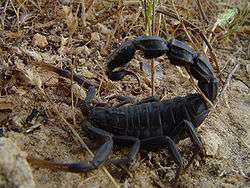Fattail scorpion
Fattail scorpion or fat-tailed scorpion is the common name given to scorpions of the genus Androctonus, one of the most dangerous groups of scorpions species in the world.[1] They are found throughout the semi-arid and arid regions of the Middle East and Africa.[1] They are a moderate sized scorpion, attaining lengths of 10 cm (just under 4 in).[2] Their common name is derived from their distinctly fat metasoma, or tail, while the Latin name originates from Greek and means "man killer".[3] Their venom contains powerful neurotoxins and is especially potent.[1] Stings from Androctonus species are known to cause several human deaths each year.[1] Several pharmaceutical companies manufacture an antivenom for treatment of Androctonus envenomations.[4]
| Fattail scorpion | |
|---|---|
 | |
| Arabian fat-tailed scorpion, Androctonus crassicauda. | |
| Scientific classification | |
| Kingdom: | |
| Phylum: | |
| Subphylum: | |
| Class: | |
| Order: | |
| Family: | |
| Genus: | Androctonus Ehrenberg, 1828 |
| Diversity | |
| About 18 species | |
Geographic range
Androctonus is widespread in North and West Africa, the Middle East and eastwards to the Hindukush region. Countries where Androctonus species live include: Armenia, Morocco, Algeria, Tunisia, Libya, Egypt, Togo, Palestine, Israel, India, Lebanon, Turkey, Jordan, Saudi Arabia, Yemen, Oman, United Arab Emirates, Qatar, Kuwait, Iraq, Iran, Afghanistan, Bahrain and Pakistan.
Etymology
A rough English translation of the name Androctonus is "man-killer", from the Ancient Greek anḗr, andrós (ἀνήρ, ἀνδρός), meaning "man" and kteínein (κτείνειν), meaning "to kill". Crassicauda means fat-tailed, from the Latin crassus meaning "thick" or "fat" and cauda, meaning "tail". Androctonus crassicauda is widespread throughout the Middle East and its name means "fat-tailed man-killer". Similarly, the Latin word for South is australis, from which Androctonus australis, "southern man-killer", derives.
Taxonomy

Taxonomic reclassification is ongoing, sources tend to disagree on the number of species.
Androctonus Ehrenberg, 1828 (29 species):
- Androctonus aeneas C. L. Koch, 1839*
- Androctonus afghanus Lourenço & Qi, 2006*
- Androctonus aleksandrplotkini Lourenço & Qi, 2007*
- Androctonus amoreuxi (Audouin, 1826)
- Androctonus australis (Linnaeus, 1758)
- Androctonus baluchicus (Pocock, 1900)*
- Androctonus barbouri (Werner, 1932)*
- Androctonus bicolor Ehrenberg, 1828
- Androctonus cholistanus Kovarik & Ahmed, 2013*
- Androctonus crassicauda (Olivier, 1807)
- Androctonus dekeyseri Lourenço, 2005*
- Androctonus donairei Rossi, 2015*
- Androctonus eburneus (Pallary, 1928)*
- Androctonus finitimus (Pocock, 1897)
- Androctonus gonneti Vachon, 1948*
- Androctonus hoggarensis (Pallary, 1929)
- Androctonus liouvillei (Pallary, 1924)*
- Androctonus maelfaiti Lourenço, 2005*
- Androctonus mauritanicus (Pocock, 1902)
- Androctonus maroccanus Lourenço, Ythier & Leguin, 2009*
- Androctonus pallidus Lourenço, Duhem & Cloudsley-Thompson, 2012*
- Androctonus robustus Kovarik & Ahmed, 2013*
- Androctonus santi Lourenço, 2015*
- Androctonus sergenti Vachon, 1948
- Androctonus simonettai Rossi, 2015*
- Androctonus tenuissimus Teruel, Kovarik & Turiel, 2013*
- Androctonus tigrai Lourenço, Rossi & Sadine 2015*
- Androctonus togolensis Lourenço, 2008*
- Androctonus tropeai Rossi, 2015*
In captivity
Despite the risks of keeping such a dangerously venomous species in captivity, Androctonus scorpions are frequently found in the exotic animal trade, A. amoreuxi and A. australis being the most commonly available. The fat-tailed scorpion's main diet when in captivity consists of cockroaches, grasshoppers, and crickets. Scorpions will generally try to kill and eat anything which moves and is smaller than themselves. To simulate the desert environment, the enclosure used to keep the scorpion in must be kept at a temperature of between 26 and 30 degrees Celsius (79–86 °F).
References
- Hendrixson, B. E. 2006. Buthid scorpions of Saudi Arabia, with notes on other families (Scorpiones: Buthidae, Liochelidae, Scorpionidae). In W. Büttiker, F. Krupp, I. Nader & W. Schneider (eds.), Fauna of Arabia (pp. in press, ~100 pages). Basel, Switzerland: Karger Libri.
- "Archived copy". Archived from the original on 2017-09-12. Retrieved 2017-09-12.CS1 maint: archived copy as title (link)
- "Dictionary of Scientific Scorpion Names" (PDF).
- "Antidotes In Depth, Jeffrey N. Bernstein" (PDF).